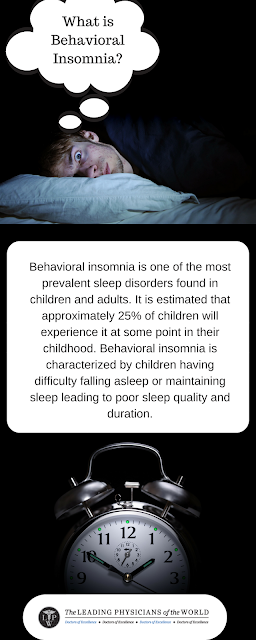Behavioral insomnia in Children
Sleep
problems are prevalent in infants, children, and adolescents. Approximately 25%
of children experience difficulties with some aspect of sleep.Moreover, 27% of
children are sleeping less than the recommended amount for their
age. Although the prevalence of sleep disorders is high, it is crucial to
note that rates vary greatly depending on the specific sleep disorder. For instance,
behavioral insomnia, the most common sleep disorder, has a very high prevalence
rate (20%–30%), whereas the prevalence rates are much lower for disorders such
as sleep apnea,sleep related movement disorder, and parasomnias such as night
terrors.
What is Behavioral insomnia in Children (BIC)?
Behavioralinsomnia is one of the most common sleep disorders found in children. It is
estimated that approximately 25% of children will experience it at some point
in their childhood. Behavioral insomnia is characterized by difficulty falling
asleep or maintaining sleep leading to poor sleep quality and duration. BIC is
very similar to poor sleep hygiene practices in adults, where the
ability and opportunity to sleep are present, but poor practices lead to sleep
loss. There are two main types of behavioral insomnia: sleep-onset association
and limit-setting.
Symptoms of Insomnia in Children
Generally, children
need more sleep than adults. This varies somewhat based on age. When sleep
is needed, a child will simply fall asleep and get it. It is best to optimize
the amount of time in bed overnight to meet these sleep needs. Younger children
may take 1-2 naps during the day to get adequate rest. By the age of 4 or 5,
most children will stop taking daytime naps. Children who do not sleep enough begin
to have problems during the daytime. Children become cranky, refuse to
cooperate with simple requests, and suffer from complete meltdowns. Older
children may begin to have problems at school, with poor attention, and
impaired school performance. Beyond simply being unable to fall asleep, other
aspects of behavior and even growth spiral out of control.
Diagnosis and Treatment
The
diagnosis of BIC relies on report of parent or caregiver, as opposed to the
self-reported complaints in adult insomnia. Adult insomnia is generally treated
with sleep restriction and stimulus control. And these concepts are important
in children as well, however for treatment of BIC parental teaching about
behavior management such as limit-setting, extinction, and operant theory is
additionally needed.
How to Improve Insomnia in Children
The two
types of behavioral insomnia can improve quickly with education and observation
of consistent rules. In some cases, further assistance may be needed. It can be
very helpful to discuss concerns with a pediatrician or even a pediatric sleep
specialist. Children with special needs may require additional support. In some
cases, melatoninmay be used as a sleep aid. If you are struggling, make
sure to get the support that you need so that everyone in the house can sleep
better.
Giving your
child a consistent routine will help them understand expectations that you have
of them, and that they can expect from you. Consistency is the key in
establishing bedtimes, and behavior will often fall in line in a short amount
of time. Children's sleep habits should always be discussed with their
pediatrician. Typical discussions should include regularity of sleep and
duration, bedtime resistance and sleep onset delay, night awakenings, and any
potential sleep disorders such as snoring. Parents concerned about their
children's sleep habits should record their sleep activity in a sleep diary
that includes intended bedtime, sleep-onset, and duration of sleep, amount and
duration of awakenings.




Comments
Post a Comment